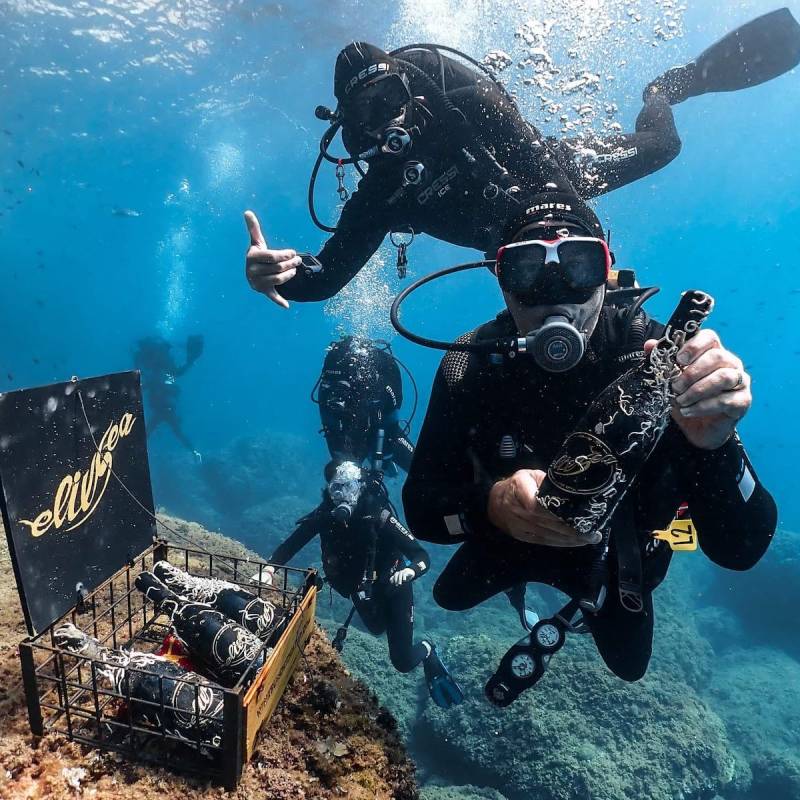
In 1998, when divers in the Baltic Sea found champagne bottles in a Swedish schooner that had been wrecked back in 1916, they had no idea what would follow. The divers brought the bottles up to land and opened one. Amazingly, the champagne was completely drinkable and it tasted good — really good.
Videos by TravelAwaits
Although it would take a few years for the idea to take off, this was the birth of underwater wine. If the wine from a wrecked Swedish schooner was good, winemakers mused, why not replicate it? Sensing a possible new selling point, but also an interesting experiment to undertake, they did just that.
Underwater wine is wine that has been purposefully aged underwater. This is usually done in the sea, but it has also been done in lakes. It’s something of a voyage in discovery as winemakers were unsure of what would happen when they first attempted this. Would it work? Would the wine be as drinkable as that first shipwreck wine? It is still about discovery, but now, winemakers at least know that the results will be positive. Underwater wine is great wine.
Today, it’s a thriving element of winemaking and a quirky draw for tourists to any underwater winery, but it does also have practical uses. It’s different to aging wine on land, and here’s why:
Underwater Wineries Around The World
Underwater wine began by accident, really, but that first dive of discovery has inspired many other wineries to embark on their own underwater wine adventures. Underwater wineries started springing up all over Europe from 2010 onwards, when they found that the Mediterranean Sea was the perfect place to sink their wines. There are now underwater wineries in Spain, Croatia, Portugal, Greece, and Italy.
As they saw success with this venture, other wineries around the world took notice and now there are underwater wineries further afield in South Africa, Brazil, Argentina, Australia, and Chile. Some of these wineries run as tourist attractions, while others simply produce the wine.
There have been other underwater wine experiments conducted by wineries that didn’t adopt the practice as routine due to permission issues in the country or area. But for the most part, underwater wineries are spreading and becoming more popular.

Why Is Wine Aged Under Water?
Although this started as something of a curiosity, and some wineries began storing wine in the sea just to find out what would happen, what they discovered has turned underwater wine into a viable business opportunity.
At ElixSea winery in Spain, they soon found that the wine they stored in the sea aged faster than the wine they stored on land, but with the same quality maintained. This means wine can be aged at a rate that speeds up production. ElixSea ages their wines for 12 months on land in French oak barrels, before submerging them in the sea for another 6 months. The result is a wine that tastes as if it is much older than it really is.
As with most journeys of adventure and discovery, the question of “Why do this?” is easily answered — to find out where it leads. But since the process became established, the answer is much simpler — greater production and great quality creates a win-win situation. Plus, the possibilities for tourism are always expanding. Visits to wineries are more popular than ever, so if you have a winery that’s different from all the others and offers a unique experience, visitors will love it.

What The Wine Tastes Like
The first thing to say is, it tastes good! As with all wine, the taste varies from grape to grape and bottle to bottle, but on the whole, the taste of underwater wine tends to linger a little longer than land-aged wines.
Some have a slightly metallic, almost iron aftertaste, but it’s pleasant, and not at all unnatural. There’s often a mineral taste, salty, but it’s good to remember the saltwater that surrounds the bottles (or tanks) does not interact with the wine at all. Any saltiness or mineral taste is naturally occurring in the wine. The saltiness brings out the tannins and it’s this that creates the distinctive long finish of the wine.
I tried a Romagna underwater wine, and I could taste the saltiness and the metallic aftertaste, but also peach. What is for sure is these wines do taste as if they deserve their price tag, which is considerably higher than regular wines. These are good wines. Many people think this is just a gimmick, a fad, but they really do taste like fine wines, with a little quirkiness added in.
Austrian winemaker Josef Moth, who sank tanks of champagne deep down in Lake Constance, observed that the wines that emerged were more aromatic than the wine he’d aged on land. Moth had taken his wine down to a depth of 60 meters, so much farther than the usual 20 meters, and he believes the taste difference is very obvious. He consulted scientists and Professor Robert Steidl, head of the Federal Office for Viticulture, all of whom agreed something significant had happened to the taste.

How To Visit
Some underwater wineries, like the Edivo Vina winery in Croatia — the first underwater winery in the country — offer winery tours with a difference. Before you taste the wines at Edivo Vina, you slide into your wetsuit, and you dive down 20 meters under the sea to take a tour of these very unusual wines in storage. These are guided dives with professional divers, so it’s completely safe. But you don’t have to dive to experience the wine. You can still enjoy the ceremonial opening of one of these bottles of wine when the divers return to the surface. You can enjoy a meal right by the sea while your waiter uncorks your special underwater wine and you can enjoy the experience entirely from land if you want to.
At Bodega Crusoe Treasure winery in Spain, guests are given a presentation and a talk about the winery and the process of aging wine underwater, followed by a wine tasting. They also offer visitors boat rides with wine tastings on-board, which is a lovely way to appreciate these wines that have been stored deep below the surface you’re floating on. There’s no diving here, so if you prefer to relax on a boat or by the sea and taste the wines, this is an interesting trip.
And at ElixSea, you can do a little taste test of your own when you are served their land-aged wine alongside their underwater wine, to see if you can tell the difference. You can buy the wines from the wineries, but check on your own country’s import guidelines if you want to take some home.
A Short Guideline To Purchasing Underwater Wines
Underwater wine is not available to purchase in the U.S. The Alcohol and Tobacco Tax and Trade Bureau (TTB) has declared underwater wine “unadulated,” as it is deemed to be stored in unsanitary conditions, and is illegal in the U.S. In 2013, Mira Winery submerged their bottles in Charleston Harbor, but that is the last and only time wine was submerged in U.S. waters due to rules and permissions being considered after.
But underwater wine is perfectly legal in most other countries and you can buy it easily while you are visiting. If you do want to buy a bottle, you’ll find it’s much more expensive than land-aged wine. The bottle of wine often comes with barnacles attached, and sometimes the winemakers purposefully decorate the bottles in this way, so these barnacles might be real, and they might not be.
Underwater wine is expensive, but be wary of any cheaper versions and don’t be tempted to opt for something that seems like a bargain. Some underwater wineries submerge cheap table wine of low quality just to be able to sell it at a higher price.
If you’re interested in wine outside of the U.S., check out these stories:
